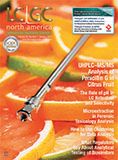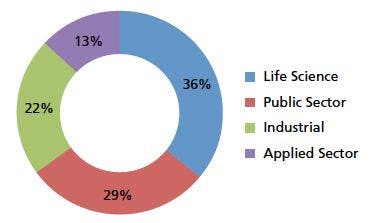Evaluating the Potential of HPLC with IMS-MS for Metabolomics
LCGC North America
Multidimensional liquid chromatography strategies are the most widely used method for increasing the number of spatially resolved components and reducing stress on mass spectrometric detection. However, the stress placed on a secondary dimension in a comprehensive on-line methodology is very high. An increasingly attractive approach is the coupling of high performance liquid chromatography (HPLC) with ion mobility spectrometry hyphenated to mass spectrometry (IMS-MS). Tim Causon and Stephan Hann of the University of Natural Resources and Life Sciences in Vienna, Austria, spoke to The Column about their work evaluating this approach and exploring its possibilities for metabolomics.
Q. Your research explored the potential of high performance liquid chromatography (HPLC) with ion mobility spectrometry hyphenated to mass spectrometry (IMS-MS) for nontargeted analysis strategies. Why has the combination of HPLC and IMS-MS garnered attention in this area?
Tim Causon:
There are already a number of interesting “flavors” of IMS-MS instruments around that rely on different IMS mechanisms, some of which have been available already for a few years on the market. Some of these approaches are already being used in combination with HPLC and there are plenty of options out there. Drift-tube (DT-) IMS-MS has only recently become commercially available for routine coupling with HPLC, and I think that this low-field IMS approach has some quite attractive properties for adding on to conventional HPLC in combination with high-resolution MS (HRMS). In particular, the ability to accurately determine a collisional cross section (CCS) value under low-field conditions via the low-field equation (Mason-Schamp) is particularly interesting as a physical property that we can eventually use in databases.
Stephan Hann:
The introduction of a technique allowing the measurement of a “new” physical property of a molecule and its integration into a LC–MS-based workflow is highly interesting for analytical chemists and follow up interdisciplinary research. Of course, the new drift-time dimension leads to an increased selectivity in many cases, but there are also other benefits that can be exploited, especially in nontargeted analysis-for example, the fact that drift-tube IMS is a generic approach that works for all ions entering the drift tube. Additionally, it allows binning and feature alignment algorithms to make use of drift spectra (in addition to chromatographic signals) for recognition and combination of ion signals as molecular features belonging to one compound with more confidence. This will significantly increase the quality and reliability of compound detection within nontargeted workflows.
Q. What does this approach offer against other column-based multi-dimensional strategies for liquid chromatography?
TC: I am a big fan of multidimensional HPLC in combination with MS and I think it is going to continue to be an important topic for many applications, which need that really high degree of chemical separation prior to ionization such as proteomics. I don’t think that using drift-tube IMS can be a replacement in all cases because the separation occurs after the ionization interface, but there are other aspects to consider for this type of multidimensional approach, particularly for identity confirmation across different samples.
SH: On the practical side, while column-based HPLCxHPLC is starting to become realistic for users with commercial instrumentation, method development, data assessment, and long-term robustness are going to remain challenging for users. HPLCxHPLC and parallel column approaches (1) are beneficial if one-dimensional (1D) chromatography suffers from matrix problems, low selectivity, or low retention factors. The latter drawback cannot be compensated by IMS, but we already know that drift-tube IMS can improve signal-to-noise ratios in high-matrix samples and enable the separation of compounds, which cannot be distinguished in the LC domain, or by accurate mass measurement. In addition to retention time, drift-tube IMS delivers a new “qualifier,” specifically drift time (or CCS), with a precision below 0.5%-this is often better than the precisions we achieve for retention times in two-dimensional (2D) chromatography. Furthermore, HPLC–IMS-MS doesn’t require any additional analysis time or solvent for the analysis-we can just switch the IMS functionality on or off as we require.
Q. Your research approached HPLC–IMS-MS theoretically. What were your major theoretical considerations and findings?
TC: We rely a great deal on the combination of HPLC and high resolution MS in our laboratory and with the acquisition of a new drift-tube IMS-MS instrument, we wanted to explore how this would help our metabolomics workflows in particular. I originally trained in the area of HPLC, so the idea was to explore these concepts using the language of chromatographers in a theoretical framework. What we found was that sample peak capacity is not so difficult to describe in the ideal case with values of 10–30 possible in most cases, and it is actually rather like describing isocratic HPLC in a simplistic sense. Secondly, we focused on determining how much difference in CCS values would be required to identify or quantify isomeric compounds that are being coeluted (2). If experimental parameters that influence IMS resolution outside of the drift tube are also included (as shown by work from Vanderbilt University [3]), it is a nice way to estimate whether adding drift-tube IMS is really going to be able to solve our analytical goals in a given case. Eventually, we mustn’t forget that shape-to-charge (IMS) and size-to-charge (MS) display only a limited orthogonality, so it is really important to have a good handle on what we can and cannot resolve with this combination before we invest our time in method development.
Q. Did your research uncover theoretical limitations to the combination of HPLC and IMS (-MS)?
TC: The understanding of peak capacity is a great place to start a conversation about what drift-tube ion mobility can add as an additional on-line separation, but it does not describe the full situation for this combination. Firstly, we know that a high-resolution mass spectrometer can resolve a lot of the separation problems that we are facing, which can make IMS separation seem not so valuable at first glance. Secondly, we have to keep in mind that this combination will not help with ion suppression issues, which is quite different to the situation with HPLCxHPLC–MS.
SH: As usual, a new technique faces limitations and challenges. As we are one of the first groups transferring metabolomic methods from LC–quadrupole time-of-flight (QTOF)-MS systems to LCxIMS–QTOF-MS, we encounter intrinsic problems of small molecules, for example space charge effects leading to losses during the trapping process. An additional challenge is more related to data processing and concerns the separation of certain molecular features, such as doubly charged ions or dimers from the original ions (singly charged isotopologues) in the drift tube-the realignment of these features is desirable and needs fit-for-purpose software algorithms.
Q. What could be done to address these challenges?
SH: Together with other IMS users we see that trapping for a shorter time prior to the IMS separation but more often (so-called multiplexing) can solve such problems, especially in the low molecular mass region, enhancing signal-to-noise ratios and metabolite coverage. Evidently, the interlaced signals obtained by multiplexing are complex and the de-multiplexing needs more processor time.
TC: While the separation of IMS does not always resolve separation problems that the combination of HPLC–MS cannot, it helps make up for chromatographic variability especially from sample matrix issues. The ability to extract a CCS value with high precision really gives an extra dimension of confidence in feature alignment across samples. Now we have retention time, drift-time/CCS, and a filtered high-resolution mass spectrum associated with each extracted feature. We need to standardize some details on how we annotate all of this information, but I think that we are already on the way to making the best use of this information.
The precision of the drift time and, ultimately, the collisional cross-section value is a parameter that really starts to help eliminate false positives. We need to work hard to look at reproducibility across instruments and figure out the best way to add drift information to HPLC–MS databases, but I believe that these are things that can be achieved.
Q. You extended your theoretical thinking toward an even more powerful approach of HPLCxHPLCxIMS-MS. How viable do you think this approach could be and what would be the major challenges if it were to be considered for use?
TC: More separation before the MS is definitely something that should be considered for extremely complex and dirty samples as long as we can manage to develop tools to handle the data extraction, assist with interpretation, and eventually make a workflow that is accessible for users. Improved preparation of the sample for the IMS-MS, whether by selective sample preparation methods or additional separation steps, will continue to be important development areas for nontargeted methods and trace analysis in complex samples. What drift-tube IMS can really offer is the addition of simple but highly repeatable drift spectrum information that we can use to describe and confirm the presence of a compound.
References
- K. Klavins et al., Anal. Chem. 86(9), 4145–4150 (2014).
- T.J. Causon and S. Hann, J. Chromatogr. A1416, 47–56 (2015).
- J.C. May et al., Analyst140, 6824–6833 (2015).
Tim Causon is a Senior Scientist in the group of Instrumental Analytical Chemistry and Metabolomics at the Department of Chemistry of the University of Natural Resources and Life Sciences (BOKU-Vienna). His current research interests center on mass spectrometry and separation science, including the metabolomic study of cell factories, fundamental analytical studies, and application developments for both targeted and nontargeted workflows.
Stephan Hann heads the group of Instrumental Analytical Chemistry and Metabolomics at BOKU-Vienna. The research of his group aims at the development and application of analytical methods in MS-based metabolomics and ultratrace analysis applied to a broad range of research topics.

Miniaturized GC–MS Method for BVOC Analysis of Spanish Trees
April 16th 2025University of Valladolid scientists used a miniaturized method for analyzing biogenic volatile organic compounds (BVOCs) emitted by tree species, using headspace solid-phase microextraction coupled with gas chromatography and quadrupole time-of-flight mass spectrometry (HS-SPME-GC–QTOF-MS) has been developed.
Identifying PFAS in Alligator Plasma with LC–IMS-HRMS
April 15th 2025A combination of liquid chromatography ion mobility spectrometry, and high-resolution mass spectrometry (LC–IMS-HRMS) for non-targeted analysis (NTA) was used to detect and identify per- and polyfluoroalkyl substances (PFAS) in alligator plasma.













